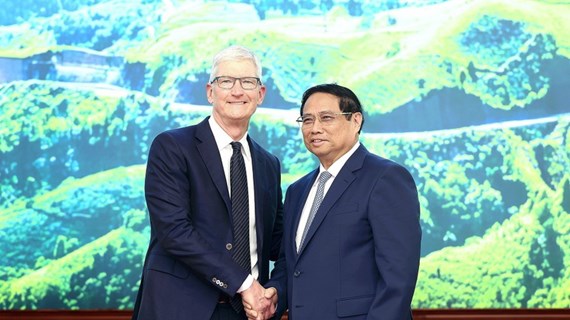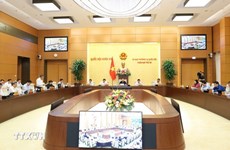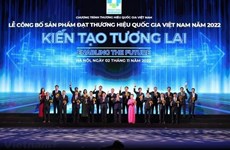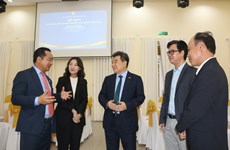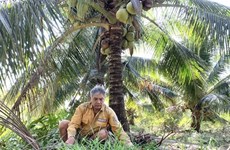WTO accession helps Hai Duong succeed: paper
After seven years of Vietnam's integration into the global economy,
there have been prominent developments in foreign direct investment and
goods export in the northern province of Hai Duong. Insight by the Hai
Duong Newspaper online.
After seven years of Vietnam's integration into the global economy,
there have been prominent developments in foreign direct investment and
goods export in the northern province of Hai Duong. Insight by the Hai
Duong Newspaper online.
Vietnam joined the World Trade Organization (WTO) in early 2007 and since then, there have been prominent developments in foreign direct investment (FDI) and goods export in Hai Duong.
FDI waves
Prior to 2007, the province attracted only 132 FDI projects from 21 countries and territories with a combined registered capital of 1.461 billion USD and a total disbursed capital of 561.1 million USD.
After that year, newly licensed FDI projects in the province did not increase sharply in quantity but changed significantly in scale and quality and, at the same time, FDI enterprises’ total realised investment rose quickly.
The highlight of 2007 and 2008 was the concentration of foreign-invested projects on fields prioritised by the province, such as producing and assembling electronic products; manufacturing new materials, machinery, telecommunications and audio-visual devices, producing and assembling automobile spare parts, medical equipment, etc.
Since 2009, the influence of the global financial crisis has led to the decline of investment flows into Vietnam in general and Hai Duong province in particular, according to Vuong Duc Sang, Director of the provincial Planning and Investment Department.
However, the province has successfully lured a number of projects with big investment, such as the BOT project of Hai Duong Thermal Power Plant with a capacity of 1,200 MW and investment of 2.258 billion USD; projects of expanded Tinh Loi Garment Co., Ltd., 120 million USD, and Pacific Crystal Textile Co., Ltd., 425 million USD; Kefico Co., Ltd.’s project of producing interior equipment and automobile motors, 65 million USD, etc., thereby contributing to consolidating the position of Hai Duong as one of the localities attracting the most foreign investment in the country.
At present, there are 254 FDI projects from 23 countries and territories with a total registered capital of over 5.811 billion USD in the province. FDI enterprises’ total disbursed investment is estimated at 2.7 billion USD, accounting for 46.4 percent of the total registered investment. FDI enterprises are providing jobs for around 120,000 labourers.
Impressive export growth
Seven years after Vietnam joined the WTO, Hai Duong province’s export turnover surged from 224.6 million USD in 2006 to 2.242 billion USD in 2013.
The total export turnover hit 3.037 billion USD during the 2006-2010 period, an average increase of 57.5 percent per year (target of 25 percent per year).
With the advantages of advanced machines, devices, and techniques along with more and more flexible markets, mechanisms, and policies, the FDI sector has been developing quite rapidly, stably and always tends to rise faster than other sectors.
In addition to domestic market exploitation, the sector has also contributed to raising export turnovers, especially in such industries as footwear, garments and textiles, manufacture and assembly of electronic components, cement production, etc.
FDI enterprises’ export value gets higher with every passing year and they occupy a large proportion of the province’s total export turnover.
The enterprises' export turnover accounted for only 20.5 percent in 2000 and 48.5 percent in 2005, but up to over 96 percent of the province’s total export turnover in 2013.
The percentage of the FDI economic sector’s contribution to the province’s GDP gradually increased year after year: 13.8 percent, 16.4 percent, and 17.8 percent in 2005, 2008, and 2012, respectively.
After seven years of joining the WTO, Hai Duong exports have changed dramatically in both value and volume.
The province’s goods have been shipped to 30 countries and territories so far. Export markets for traditional commodities have continued to be maintained.
The number of import-export enterprises has increased ceaselessly in all economic sectors, from just over 80 in 2006 to more than 230 at the end of 2013.
Some major export items, including electronic products, garments and textiles, footwear, electrical wires and cables, agricultural produce, foodstuffs, etc., especially items manufactured by FDI enterprises, have seen relatively high growth rates.-VNA
Vietnam joined the World Trade Organization (WTO) in early 2007 and since then, there have been prominent developments in foreign direct investment (FDI) and goods export in Hai Duong.
FDI waves
Prior to 2007, the province attracted only 132 FDI projects from 21 countries and territories with a combined registered capital of 1.461 billion USD and a total disbursed capital of 561.1 million USD.
After that year, newly licensed FDI projects in the province did not increase sharply in quantity but changed significantly in scale and quality and, at the same time, FDI enterprises’ total realised investment rose quickly.
The highlight of 2007 and 2008 was the concentration of foreign-invested projects on fields prioritised by the province, such as producing and assembling electronic products; manufacturing new materials, machinery, telecommunications and audio-visual devices, producing and assembling automobile spare parts, medical equipment, etc.
Since 2009, the influence of the global financial crisis has led to the decline of investment flows into Vietnam in general and Hai Duong province in particular, according to Vuong Duc Sang, Director of the provincial Planning and Investment Department.
However, the province has successfully lured a number of projects with big investment, such as the BOT project of Hai Duong Thermal Power Plant with a capacity of 1,200 MW and investment of 2.258 billion USD; projects of expanded Tinh Loi Garment Co., Ltd., 120 million USD, and Pacific Crystal Textile Co., Ltd., 425 million USD; Kefico Co., Ltd.’s project of producing interior equipment and automobile motors, 65 million USD, etc., thereby contributing to consolidating the position of Hai Duong as one of the localities attracting the most foreign investment in the country.
At present, there are 254 FDI projects from 23 countries and territories with a total registered capital of over 5.811 billion USD in the province. FDI enterprises’ total disbursed investment is estimated at 2.7 billion USD, accounting for 46.4 percent of the total registered investment. FDI enterprises are providing jobs for around 120,000 labourers.
Impressive export growth
Seven years after Vietnam joined the WTO, Hai Duong province’s export turnover surged from 224.6 million USD in 2006 to 2.242 billion USD in 2013.
The total export turnover hit 3.037 billion USD during the 2006-2010 period, an average increase of 57.5 percent per year (target of 25 percent per year).
With the advantages of advanced machines, devices, and techniques along with more and more flexible markets, mechanisms, and policies, the FDI sector has been developing quite rapidly, stably and always tends to rise faster than other sectors.
In addition to domestic market exploitation, the sector has also contributed to raising export turnovers, especially in such industries as footwear, garments and textiles, manufacture and assembly of electronic components, cement production, etc.
FDI enterprises’ export value gets higher with every passing year and they occupy a large proportion of the province’s total export turnover.
The enterprises' export turnover accounted for only 20.5 percent in 2000 and 48.5 percent in 2005, but up to over 96 percent of the province’s total export turnover in 2013.
The percentage of the FDI economic sector’s contribution to the province’s GDP gradually increased year after year: 13.8 percent, 16.4 percent, and 17.8 percent in 2005, 2008, and 2012, respectively.
After seven years of joining the WTO, Hai Duong exports have changed dramatically in both value and volume.
The province’s goods have been shipped to 30 countries and territories so far. Export markets for traditional commodities have continued to be maintained.
The number of import-export enterprises has increased ceaselessly in all economic sectors, from just over 80 in 2006 to more than 230 at the end of 2013.
Some major export items, including electronic products, garments and textiles, footwear, electrical wires and cables, agricultural produce, foodstuffs, etc., especially items manufactured by FDI enterprises, have seen relatively high growth rates.-VNA





